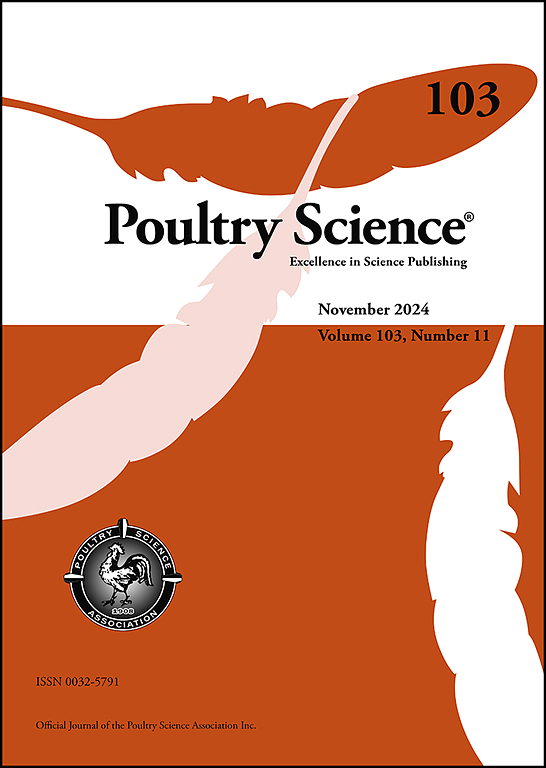探讨不同壳强度蛋鸭表型、盲肠微生物组和血清代谢组的相关性
IF 4.2
1区 农林科学
Q1 AGRICULTURE, DAIRY & ANIMAL SCIENCE
引用次数: 0
摘要
蛋壳质量在家禽业中起着至关重要的作用,影响着生物学和经济效益。然而,决定蛋鸭蛋壳强度的因素仍然知之甚少。本研究旨在探讨不同蛋壳强度鸭子的表型变化、肠道微生物群组成和血清代谢物,以确定影响蛋壳完整性的关键微生物和代谢因素。在连续饲养的四周中,在两天内收集了525个鸡蛋并对其质量进行了评估。根据蛋壳强度对鸭进行排序,分为高蛋壳强度组(HEG)和低蛋壳强度组(LEG),每组各取12只鸭(共24只)进行表型性状、肠道微生物群和血清代谢组学分析。结果显示,HEG组的尖尖厚度、中间带厚度和钝尖厚度均显著大于LEG组(P <;0.01)。此外,HEG鸭的破壳强度显著提高(P <;0.01)。HEG组的超氧化物歧化酶(P <;0.01),过氧化氢酶(P <;0.01),总抗氧化能力(P <;0.05),与LEG组比较。相反,HEG鸭的丙二醛水平显著降低(P <;0.01),表明氧化应激降低。盲肠内容物微生物学分析显示HEG组Chao1和Faith_pd指数较高(P <;0.05),而LEG组的商品覆盖指数升高(P <;0.01)。HEG组中丰度较高的是Firmicutes_A、Desulfobacterota_I、Phocaeicola_A和phascolarctobacterum_a (P <;0.05),而LEG组的普氏菌丰度更高(P <;0.05)。血清代谢组学显示,两组间积累的代谢物有1099种差异,其中LEG组的代谢物上调198种,下调131种(P <;0.05)。KEGG途径富集分析鉴定出6个碳代谢富集的代谢物和3个阳离子摄取途径富集的代谢物。综上所述,产蛋高峰期山马鸭蛋壳品质和血清抗氧化能力的差异可能与肠道菌群和代谢物的调节有关。这一假设得到了厚壁菌a、普雷沃氏菌与碳代谢和矿物质吸收相关代谢途径的相关性的支持。这些结果为今后鸭的育种和选择工作提供了理论基础。本文章由计算机程序翻译,如有差异,请以英文原文为准。
Investigating the correlation between phenotype, cecal microbiome, and serum metabolome in laying ducks with different shell strength
Eggshell quality plays a critical role in the poultry industry, influencing both biological and economic outcomes. However, the factors determining eggshell strength in egg-laying ducks remain poorly understood. This study sought to explore phenotypic variations, gut microbiota composition, and serum metabolites in ducks with differing eggshell strengths to identify key microbial and metabolic factors affecting shell integrity. Over four weeks of continuous feeding, 525 eggs were collected over two days and assessed for quality. Ducks were ranked based on shell strength and classified into high eggshell strength (HEG) and low eggshell strength (LEG) groups, with 12 ducks selected from each group (24 total) for analysis of phenotypic traits, gut microbiota, and serum metabolomics. The results revealed that sharp apex thickness, medium zone thickness, and blunt apex thickness were significantly greater in the HEG group than in the LEG group (P < 0.01). Additionally, shell-breaking strength was markedly higher in HEG ducks (P < 0.01). The HEG group also exhibited significantly higher levels of superoxide dismutase (P < 0.01), catalase (P < 0.01), and total antioxidant capacity (P < 0.05) compared to the LEG group. Conversely, HEG ducks had significantly lower levels of malondialdehyde (P < 0.01), indicating reduced oxidative stress. Microbiological analysis of cecal contents showed higher Chao1 and Faith_pd indices in the HEG group (P < 0.05), while Goods coverage indices were elevated in the LEG group (P < 0.01). The abundances of Firmicutes_A, Desulfobacterota_I, Phocaeicola_A, and Phascolarctobacterium_A were higher in the HEG group (P < 0.05), whereas Prevotella abundance was greater in the LEG group (P < 0.05). Serum metabolomics revealed 1,099 differentially accumulated metabolites between the groups, with 198 metabolites up-regulated and 131 down-regulated in the LEG group (P < 0.05). KEGG pathway enrichment analysis identified six metabolites enriched in carbon metabolism and three in cation uptake pathways. These findings suggest that differences in eggshell quality and serum antioxidant capacity in Shanma ducks during peak laying may result from the modulation of gut microbiota and metabolites. This hypothesis is supported by the correlation between Firmicutes_A, Prevotella, and the metabolic pathways related to carbon metabolism and mineral absorption. These results provide a theoretical foundation for future duck breeding and selection efforts.
求助全文
通过发布文献求助,成功后即可免费获取论文全文。
去求助
来源期刊

Poultry Science
农林科学-奶制品与动物科学
CiteScore
7.60
自引率
15.90%
发文量
0
审稿时长
94 days
期刊介绍:
First self-published in 1921, Poultry Science is an internationally renowned monthly journal, known as the authoritative source for a broad range of poultry information and high-caliber research. The journal plays a pivotal role in the dissemination of preeminent poultry-related knowledge across all disciplines. As of January 2020, Poultry Science will become an Open Access journal with no subscription charges, meaning authors who publish here can make their research immediately, permanently, and freely accessible worldwide while retaining copyright to their work. Papers submitted for publication after October 1, 2019 will be published as Open Access papers.
An international journal, Poultry Science publishes original papers, research notes, symposium papers, and reviews of basic science as applied to poultry. This authoritative source of poultry information is consistently ranked by ISI Impact Factor as one of the top 10 agriculture, dairy and animal science journals to deliver high-caliber research. Currently it is the highest-ranked (by Impact Factor and Eigenfactor) journal dedicated to publishing poultry research. Subject areas include breeding, genetics, education, production, management, environment, health, behavior, welfare, immunology, molecular biology, metabolism, nutrition, physiology, reproduction, processing, and products.
 求助内容:
求助内容: 应助结果提醒方式:
应助结果提醒方式:


